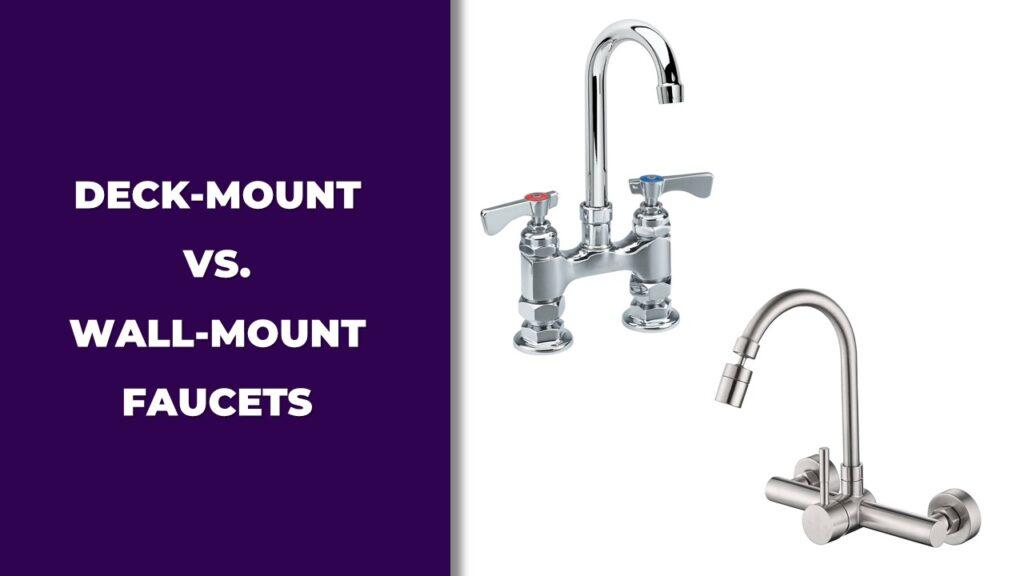
Deck-mount faucets sit right on the sink or countertop. You connect the water lines underneath, and most sinks come ready with holes for them. They’re common, easy to install, and come in tons of styles. Wall-mount faucets, on the other hand, attach to the wall just above the sink. They free up your counter, look neat and modern, but the plumbing has to run through the wall, which makes installation trickier.
This article walks you through the practical differences between deck mount vs wall mount faucets, how each type is installed, what they look like in real bathrooms and kitchens, and how easy or hard they are to clean or repair. If you’re weighing your options, we’ll help you figure out which one works better for your space and lifestyle.
What Are Deck-Mount Faucets?
Deck-mount faucets, one of the most common types of faucets, sit directly on top of your sink or countertop. The handles and spout are all connected through holes in the surface, and the water lines run below. This is the most common faucet type you’ll see in kitchens and bathrooms because it’s simple to install and works with most sink setups.
Now, let’s look at what makes them a popular pick and where they might fall short.
Pros of Deck-Mount Faucets
- Easy to Install: Most sinks and countertops already have the right holes for them, which makes installation pretty straightforward.
- Plenty of Options: Since they’re more common, you’ll find them in lots of styles, finishes, and shapes.
- Easier to Fix: If there’s ever a leak or a loose connection, the plumbing is under the sink and easy to reach.
- Budget-Friendly: They generally cost less to install since there’s no need to open up the wall.
Cons of Deck-Mount Faucets
- Takes Up Space: The base and handles sit on the counter, so they can crowd your sink area, especially in smaller bathrooms.
- Harder to Clean Around: Water, soap, and gunk can build up around the base, especially for homes with mineral-rich water. That’s why many people prefer kitchen faucets for hard water to cut down on buildup.
- Not as Sleek: If you’re aiming for a modern or minimal look, they might feel a bit bulky depending on the design.
What Are Wall-Mount Faucets?
Wall-mount faucets are attached directly to the wall above your sink. Instead of sitting on the countertop, they hang over the basin, leaving the counter completely open. This type of faucet is popular in modern bathrooms or kitchens where space is tight or where a clean, floating look is preferred.
They’re not as commonly used, but they do have a few standout perks and tradeoffs.
Pros of Wall-Mount Faucets
- Saves Counter Space: Since nothing is mounted on the sink or counter, you get more room for soaps, toothbrush holders, or just a cleaner look.
- Easy to Wipe Around: With the faucet off the counter, there’s less grime build-up. It makes daily cleaning faster and easier.
- Modern Appearance: If you’re going for a spa-like or high-end look, wall-mounts have that stylish feel.
- Great for Vessel Sinks: These faucets work really well with above-counter sinks where the faucet needs a bit more height.
Cons of Wall-Mount Faucets
- Tricky Installation: You’ll need to run plumbing through the wall, which usually means calling in a pro.
- Harder to Repair: If there’s a leak or plumbing issue, you may have to open the wall to fix it.
- Fewer Style Choices: Compared to deck-mount options, there aren’t as many finishes or styles to choose from.
- Precise Measurements Needed: If the faucet isn’t positioned just right, it can splash water outside the sink or be uncomfortable to use.
Key Differences Between Deck-Mount and Wall-Mount Faucets
Deck-mount and wall-mount faucets may do the same job, but how they’re installed, how they look, and how they fit into your space can be quite different. Deck-mount faucets sit directly on the sink or countertop, making them easier to install and more common in older or traditional homes. Wall-mount faucets, on the other hand, are installed into the wall above the sink. They free up counter space and create a clean, modern look, but they need more planning and plumbing work.
If you’re stuck between the two, the table below gives a quick side-by-side view of how they compare.
Table: Side-By-Side Comparison
| Feature | Deck-Mount Faucet | Wall-Mount Faucet |
| Installation | Mounted on a countertop or sink | Mounted on the wall above the sink |
| Plumbing | Easy access under the sink | Plumbing hidden in the wall, harder to reach |
| Ease of Installation | Easier, often DIY-friendly | Requires professional plumbing work |
| Design Variety | More finishes and styles are available | Fewer styles, limited manufacturer options |
| Space Usage | Takes up counter space | Frees up counter space |
| Cleaning | More buildup around the base | Easier to wipe the surface clean |
| Cost Estimate | $100 to $300 for faucet, $100 to $250 for installation | $150 to $500 for faucet, $300 to $700 for installation |
| Ideal For | Traditional or remodeled spaces | Modern or minimalist rooms, small bathrooms |
Now, let’s break those differences down a bit more.
Installation Complexity
Deck-mount faucets are usually the easier of the two to install. If your sink or countertop already has holes, you’re halfway there. The water lines go through the deck and connect underneath, which means fewer surprises.
Wall-mount faucets are a bit more involved. Since the plumbing has to run inside the wall, you might need to open things up. That’s why these usually require a plumber. They also need to be placed at the right height and distance from the sink, or things can get messy; literally.
Design Aesthetic
Deck-mount faucets are familiar and flexible. You’ll find them in nearly every finish and style, including high-end kitchen faucets designed for upscale spaces, whether you’re going for farmhouse, classic, or something modern.
Wall-mount faucets lean toward the sleek and minimalist side. They often give a space that spa-like feeling. While they do look stylish, your design choices may be more limited compared to deck-mount options.
Space Usage
If you’re working with limited counter space, a wall-mount faucet can help clear things up. With no base or handles crowding the sink area, you have more room for soap dispensers, toothbrushes, or whatever else lives near your sink.
Deck-mounts do take up some space, especially if the faucet has a wide base or separate hot and cold handles. In tighter areas, this could feel a little cramped.
Maintenance and Cleaning
Deck-mount faucets can be trickier to clean around, especially if there’s gunk hiding behind the base. Water spots and grime tend to build up there over time.
Wall-mount faucets leave the counter more open and easier to wipe down. No awkward corners or tight spots. That alone can make cleaning day feel a bit less annoying.
Cost Comparison
Deck-mount faucets are usually more budget-friendly. You can get a good-quality faucet for around $100 to $300, and installation typically runs between $100 to $250, depending on your area and whether you’re hiring help or doing it yourself.
Wall-mount faucets tend to cost more. The faucet alone might range from $150 to $500, depending on the finish and brand. But the big cost comes in installation. Since it involves plumbing inside the wall, expect to pay $300 to $700, especially if drywall has to be opened and patched.
So, while both can look great, the wall-mount option can easily run double the cost of a deck-mount setup.
When To Choose a Deck-Mount Faucet
Choose a deck-mount faucet if your sink or countertop already has holes and you want something simple to install with plenty of style choices. This is the most common setup in many homes and works well in kitchens and bathrooms alike, especially if you’re already familiar with what a kitchen faucet includes and how it’s typically installed.
Deck-mount faucets are a great pick during a remodel, especially if you’re keeping your existing sink or vanity. Since the plumbing stays under the counter, you don’t need to deal with anything inside the wall. It’s less hassle, and usually easier on the budget. If you’re not looking to hire a plumber or make big changes, this style makes life easier.
They also give you a wide range of looks to pick from. Whether your taste leans traditional, industrial, or clean and modern, you’ll find plenty of finishes and handle types that fit. It’s a flexible option that makes sense for most setups and keeps future repairs simple.
When To Choose a Wall-Mount Faucet
Choose a wall-mount faucet if you’re going for a clean, modern design and want to keep your counter as open as possible. This style is a great fit for smaller bathrooms, vessel sinks, or any space where every inch counts.
Wall-mounted faucets offer a more open, airy look. Since they don’t sit on the countertop, cleaning around the sink is quicker and tidier. This kind of faucet works especially well in bathrooms with floating vanities or sinks that sit above the counter, where a taller spout makes more sense.
That said, this setup takes more work behind the scenes. The plumbing needs to go into the wall, and getting the height just right really matters. It’s not something most people want to DIY. But if you’re already remodeling or building new, and you’re after that spa-like style, a wall-mount faucet can be a great way to tie it all together.
Cost Comparison And Installation Considerations: Deck-Mount vs. Wall-Mount Faucets
Deck-mount faucets usually cost less and are easier to install, while wall-mount faucets tend to cost more because of the extra plumbing work involved. If you’re planning a full remodel, the difference may not feel huge. But for quick updates or tight budgets, the price gap can matter quite a bit.
Average Costs (Faucet + Installation)
Deck-mount faucets are the more affordable option in most cases. A good-quality deck-mounted faucet usually costs between $100 and $300, depending on the brand and finish. Installation is simple and often runs around $100 to $250 if you hire someone. If you’re handy, you might not need help at all.
Wall-mount faucets, on the other hand, start around $150 and can go up to $500 or more. The real difference shows up in the installation. Since the water lines run inside the wall, you’re looking at $300 to $700 for labor, especially if drywall needs to be cut, patched, or tiled. It adds up fast if the plumbing layout has to change.
DIY vs. Professional Help
Installing a deck-mount faucet is usually a good DIY project, especially if you’re replacing an old faucet and the holes already match. The connections are easy to reach under the sink, and the tools required are basic.
Wall-mount faucets, though, are a different story. Getting the faucet at the right height and angle takes precise measurement. Plus, working inside a wall can be tricky. Unless you’re doing a full bathroom renovation or you have plumbing experience, hiring a pro is usually the smart move. It’s not impossible to DIY, but it’s easy to mess up.
Final Thoughts: Which One Should You Choose?
If you’re feeling stuck between the two, you’re not alone. A lot of people hit this same wall when updating a bathroom or kitchen. It really comes down to how much space you have, what kind of look you want, and whether you’re okay with doing a bit more work behind the scenes.
Go with a deck-mount faucet if you want something simple, practical, and easy to install. It’s great for quick updates and gives you plenty of style choices without breaking the bank. This is a solid pick if you’re working with an existing sink or don’t want to mess with the wall.
Choose a wall-mount faucet if you’re building new or doing a full remodel and want a cleaner, more open look. It’s especially useful for smaller spaces or when you’re using a vessel sink. Just be ready for a little more cost and a more involved installation.
At the end of the day, both options work well. One just might fit your space and project timeline better than the other. Think about how much room you have, how much you’re willing to spend, and whether the features align with your needs, especially if you’re still figuring out how to buy a faucet that fits both your space and your style. That usually clears things up fast.
Related FAQs
Which Is Easier to Install, Deck-Mount or Wall-Mount Faucets?
Deck-mount faucets are easier to install because the plumbing stays under the sink and doesn’t need wall work. Wall-mount faucets usually require a plumber since pipes must be run inside the wall, making the job more complex and costly.
Do Wall-Mount Faucets Leak More Often Than Deck-Mount Faucets?
No, wall-mount faucets don’t leak more by default. But when they do, fixing them can be harder since the plumbing is inside the wall. Deck-mount leaks are easier to spot and repair because everything is more accessible.
Can I Switch From a Deck-Mount to a Wall-Mount Faucet Easily?
It’s possible, but not simple. You’ll need to reroute your plumbing inside the wall, patch the countertop holes, and measure carefully. It’s usually done during a full remodel or new build when the wall is already open.
Are Wall-Mount Faucets Better for Small Bathrooms?
Yes, wall-mount faucets can free up counter space and make small bathrooms feel less crowded. They keep the sink area cleaner and leave more room for toiletries or just a tidier look.
Do Deck-Mount Faucets Offer More Style Choices?
Yes, deck-mount faucets come in more styles, finishes, and handle types than wall-mount ones. Since they’re more common, it’s easier to find options that fit different design themes and budgets.
What Type of Sink Works Best With Wall-Mount Faucets?
Wall-mount faucets pair well with vessel sinks and floating vanities. They give extra space above the sink and help avoid splashing. Just make sure to get the height and reach right before installation.

Dylan Foster is a family man with years of hands-on experience in plumbing, household maintenance, and fixing everyday issues around the home. A former plumber, Dylan knows what it’s like to deal with tricky leaks, worn-out parts, and all the little problems that pop up in a house. From plumbing repairs to kitchen fixes and garden hose setups, he’s done it all. Dylan shares real-world solutions to help others keep their homes running smoothly and avoid costly mistakes.




